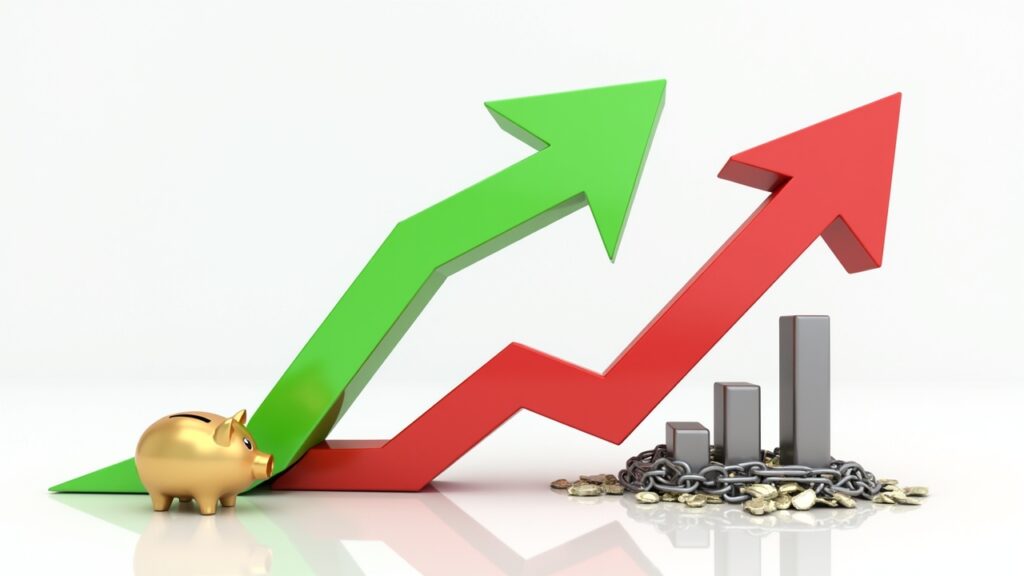Advertisements
Did you know that 56% of Americans can’t cover a $1,000 emergency expense? When I first heard that stat, I nearly choked on my morning coffee. That was me just five years ago!
Back then, I was juggling $15,000 in credit card debt while trying to decide if I should save money or pay off debt first. The constant stress was eating me alive. Every financial guru seemed to have a different opinion, and honestly, I felt like I was drowning in conflicting advice.
If you’re stuck between building an emergency fund and paying off debt, trust me – you’re not alone. This decision can feel overwhelming, but I’ve learned there’s actually a smart way to tackle both.
Why You Need Both (But Not at the Same Time)

Here’s the thing – trying to do everything at once is a recipe for failure. I learned this the hard way when my car broke down while I was aggressively paying off debt. No emergency fund meant hello, more credit card debt!
The truth is, life happens whether you’re ready or not. Your water heater doesn’t care that you’re on a debt payoff journey. Neither does your transmission or your kid’s broken arm.
But here’s where it gets tricky. Every dollar sitting in savings is a dollar not attacking that debt. And with credit card interest rates averaging around 20% APR, that debt grows faster than my teenager’s appetite!
The Starter Emergency Fund: Your Financial Safety Net
After my car fiasco, I finally understood why even Dave Ramsey recommends starting with a small emergency fund. I call it the “sleep at night” fund.
Most experts suggest $1,000 as a starter emergency fund. But honestly? That might not be enough depending on your situation. When I was starting out, I aimed for $2,500 because I drove an older car that loved surprise repairs.
Here’s what worked for me:
- I saved $500 from my tax refund (easiest money ever)
- Sold stuff I didn’t need on Facebook Marketplace
- Picked up a few weekend shifts at my side gig
- Cut my grocery budget by meal planning like crazy
It took me about three months to save that initial fund. Was it perfect? Nope. But it was enough to keep me from using credit cards when emergencies popped up.
When to Focus on Debt Payoff
Once I had my starter emergency fund, I went full throttle on debt payoff. And let me tell you – watching those balances drop was addicting!
High-interest debt is like a leak in your financial boat. The longer you ignore it, the more water (interest) pours in. I started with my highest interest rate card first – the avalanche method – though some folks prefer the snowball method of paying smallest balances first.
During this phase, every extra penny went to debt. Birthday money? Debt. Overtime pay? Debt. That random $20 bill I found in my winter coat? You guessed it – straight to debt!
But here’s a mistake I made – I got too aggressive. When my daughter needed new glasses, I almost had to dip into the credit cards again because my emergency fund was too small. Don’t be like me. Keep that safety net intact!
Building Your Full Emergency Fund
After crushing my debt (took 18 months of serious dedication), I focused on building a proper emergency fund. Most experts recommend 3-6 months of expenses, but I sleep better with 6 months saved.
This phase actually felt harder than paying off debt. There’s no enemy to defeat, no balances dropping to zero. Just slow, steady saving that sometimes felt pointless.
To stay motivated, I:
- Named my savings account “Peace of Mind Fund”
- Celebrated milestones (every $1,000 saved meant a fancy coffee treat!)
- Automated transfers so I wouldn’t be tempted to skip months
- Reminded myself why I was doing this by reading stories of people who lost jobs unexpectedly
Real Numbers: My Journey

Sometimes it helps to see real numbers, so here’s how my journey played out:
- Month 1-3: Saved $2,500 starter emergency fund
- Month 4-21: Paid off $15,000 in debt (about $833/month)
- Month 22-30: Built full 6-month emergency fund of $18,000
Your timeline might be totally different, and that’s okay! I was fortunate to have a stable job and could throw about $1,000/month at my goals. Some months were higher, some lower.
Finding Your Balance
The emergency fund vs debt payoff debate doesn’t have to be an either/or situation. Life taught me that having even a small cushion makes the debt payoff journey more sustainable.
Start with that starter emergency fund – even if it’s just $500. Then attack your high-interest debt like it personally insulted your mother. Once you’re debt-free, build that full emergency fund that’ll help you sleep like a baby.
Remember, personal finance is personal. What worked for me might need tweaking for your situation. Maybe you need a bigger starter fund because you’re self-employed. Maybe you can get away with less because you have super stable income.
The important thing is to start somewhere. Pick a path and adjust as you go. And hey, if you’re looking for more practical money tips from someone who’s been in the trenches, check out other posts on The Clear Cents. We’re all figuring this out together, one financial decision at a time!




[…] to dive deeper into managing your money as a team? The Clear Cents has tons more resources to help you and your partner build the financial future you both deserve. Because if we could do it […]